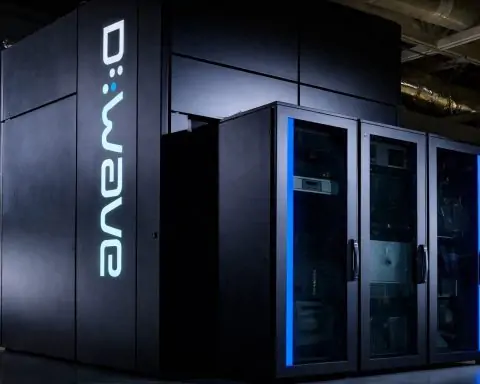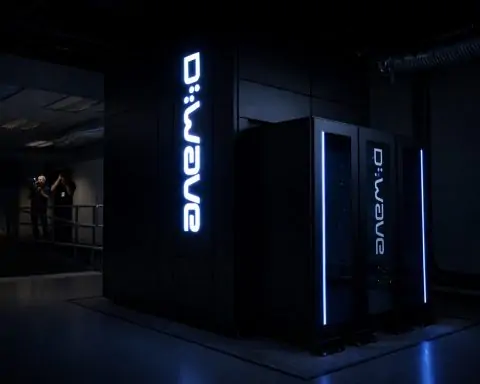Major Quantum R&D Breakthroughs
- ‘Forgotten’ Particle Rescues Quantum Computing: Mathematicians at the University of Southern California revealed that a previously discarded quasiparticle—dubbed the “neglecton”—could be the missing piece for universal topological quantum computing [1]. By adding a single stationary neglecton to a system of Ising anyons, the team showed these otherwise limited anyons can perform all logic gates through braiding alone, unlocking full computational power from particles once thought useless [2]. “It’s like finding treasure in what everyone else thought was mathematical garbage,” said USC professor Aaron Lauda, noting how an object once considered mere “quantum trash” turned out to enable a major breakthrough [3]. The work, published in Nature Communications, opens a new path to building fault-tolerant quantum computers from exotic quasiparticles.
- Single-Atom Logic Gate Slashes Qubit Overhead: Quantum scientists at the University of Sydney demonstrated a new entangling logic gate on a single atom that drastically cuts the number of physical qubits needed per logical qubit [4]. By encoding qubits with the Gottesman–Kitaev–Preskill (GKP) error-correcting code (nicknamed a “Rosetta stone” of quantum computing), the team stored two logical qubits in one trapped ytterbium ion and entangled them, achieving a universal gate set within one atom [5] [6]. “Our experiments have shown the first realisation of a universal logical gate set for GKP qubits,” said Dr. Tingrei Tan, lead author on the Nature Physics study [7]. This hardware-efficient approach is a “foundation to work towards large-scale quantum-information processing in a highly hardware-efficient fashion,” potentially easing the engineering nightmare of scaling up qubit counts [8].
- Magnetism Shields Qubits in Exotic Material: A collaboration between Chalmers University (Sweden) and Aalto University (Finland) unveiled a new quantum material that naturally protects qubits from noise using magnetism [9]. Described in Physical Review Letters, the material uses common magnetic interactions (instead of rare spin–orbit coupling) to create robust topological quantum states that resist environmental disturbances [10]. “This is a completely new type of exotic quantum material that can maintain its quantum properties when exposed to external disturbances. It can contribute to the development of quantum computers robust enough to tackle quantum calculations in practice,” said Guangze Chen, lead author and Chalmers postdoc [11]. By “baking with everyday ingredients” like magnetism rather than exotic physics, the team broadened the hunt for inherently error-resilient qubit materials [12].
- Levitated Nanodiamonds Target Quantum Gravity: Pushing the boundary between quantum mechanics and gravity, physicists at Ben-Gurion University of the Negev (Israel) advanced a matter-wave interferometer using levitated nanodiamonds. By precisely controlling the spins of nitrogen-vacancy (NV) centers in diamond, the team showed these million-atom nanodiamonds could be put into superposition just a few nanometers apart [13]. This achievement—splitting massive particles by nanoscopic distances—marks a significant step toward probing the interplay of quantum mechanics and gravity in regimes never tested before [14]. The researchers aim to use this system to test fundamental physics (like the equivalence principle) and even search for exotic phenomena (e.g. dark matter interactions) with ultra-sensitive quantum probes [15] [16].
- Doubly-Exponential Speedup in Quantum Tomography: In Berlin, scientists led by Jens Eisert introduced an algorithm that achieves a double-exponential improvement in quantum state tomography for high-dimensional states. Their new method efficiently reconstructs bosonic Gaussian quantum states and, remarkably, its accuracy does not depend on the state’s energy or photon number [17]. Using generalized adaptive heterodyne measurements, the algorithm keeps the sample complexity nearly constant regardless of how “squeezed” or energetic the state is [18] [19]. This overcomes a major limitation of prior techniques and means even highly populated light states can be characterized with far fewer measurements. The breakthrough promises faster, more scalable quantum state characterization – critical for precision metrology and verifying quantum processors – by dramatically reducing the measurements needed for complex states [20] [21].
- Error Mitigation Outguns Raw Qubits: IBM researchers reported a striking result in quantum computing hardware: using clever error mitigation, a 5-qubit quantum processor outperformed a cutting-edge 156-qubit device on a chemistry problem [22]. The team applied a software technique called “Twirled Readout Error Extinction” (T-REx) to reduce noise in a Variational Quantum Eigensolver (VQE) experiment, achieving ground-state energy estimates 10× more accurate than the larger, unmitigated system could [23]. In other words, a small quantum chip with high-fidelity operations (plus error mitigation) beat a far bigger quantum computer plagued by noise. This result underscores that improving qubit quality (via calibration and error mitigation) can matter more than sheer quantity of qubits on today’s noisy devices. It also suggests a promising near-term path: optimized error reduction and parameter tuning might unlock better performance from quantum hardware without solely waiting for scale [24] [25].
Quantum Communication & Networks
- Entanglement “Piecemaker” Boosts Quantum Networks: A joint team from QuTech (Delft) and UMass Amherst developed a new protocol, dubbed “Piecemaker,” to more efficiently distribute entanglement across quantum networks. Instead of the traditional approach – waiting to entangle all network nodes before sharing a quantum state – Piecemaker processes each entangled pair immediately upon creation, greatly reducing the need to store qubits in memory [26] [27]. By minimizing the time entangled pairs sit and accumulate noise, the protocol achieved equal or higher end-to-end fidelity compared to conventional methods, with infidelity reduced by up to 45% in simulations [28] [29]. Tests with network models up to 50 qubits showed Piecemaker can maintain high fidelity under more challenging conditions (lower link success rates, more noise), significantly expanding the range of conditions for reliable multipartite entanglement distribution [30] [31]. This resource-efficient approach, grounded in graph-state fusion techniques, could help enable more robust quantum internet links without a prohibitive qubit memory overhead.
- Broadband QKD Security Testbed: Chinese researchers have demonstrated an extensive new method to harden quantum key distribution (QKD) systems against hacking. Hao Tan and colleagues at Hefei National Laboratory built a testbench that precisely measures optical insertion loss across an extremely wide spectrum (400–2300 nm) with up to 70 dB of dynamic range [32]. This allows them to analyze how much stray light at any wavelength could pass through a QKD setup’s components – crucial for assessing Trojan-horse attacks, where an eavesdropper injects light to read secret keys. The team’s broadband analysis maps out potential vulnerabilities far beyond the normal QKD operating band [33]. Every wavelength becomes a potential attack vector to test. This comprehensive approach paves the way for certifying future QKD networks against side-channel exploits: by identifying “leaky” spectral windows, developers can plug them (with better filters, isolators, etc.), ensuring quantum cryptography remains truly unhackable [34]. Such rigorous testing is expected to be integral to next-generation secure quantum communications.
Government & Military Quantum Initiatives
- DARPA Launches “HARQ” Program: The U.S. Defense Advanced Research Projects Agency (DARPA) announced a major new initiative, Heterogeneous Architectures for Quantum (HARQ), seeking “revolutionary advances” in quantum computing [35]. The HARQ program’s solicitation calls for high-risk, high-reward research to overcome current quantum hardware limitations – from novel qubit interconnects and transducers to modular quantum memory networks and hybrid quantum-classical algorithms [36]. Rather than incremental improvements, DARPA is aiming for leap-ahead architectures (including error-corrected and distributed systems) that could scale to practical, deployable quantum computers [37] [38]. With proposal abstracts due in the fall, the agency explicitly encourages bold ideas that “accelerate progress toward scalable, secure quantum computing” for long-term national security needs [39]. HARQ reflects the Pentagon’s growing investment in quantum technology to secure a strategic edge in computing and cryptography.
- Defense Firms Partner on Quantum AI: In the private sector, companies are teaming up to infuse quantum tech into military applications. Notably, Orientom, an Asia-based quantum technology firm, announced a partnership with Deep In Sight, an AI company, to co-develop quantum-powered AI solutions for defense and intelligence use cases [40]. The collaboration (revealed August 22) will explore quantum algorithms to enhance military decision-making, logistics, and security – an area of rising interest as armed forces seek any computational advantage. This follows broader trends: defense agencies worldwide are funding joint R&D to harness quantum for ultra-secure communications, optimization of operations, and advanced simulations [41]. Recent Western intelligence reports have warned that rapid adversary progress in quantum sensing and encryption could threaten the tech balance of power [42]. Governments are responding by launching new quantum programs, public-private partnerships, and research hubs to avoid falling behind in what’s viewed as a critical technological race [43].
Industry & Investment Moves
- Strangeworks Acquires Quantagonia: In a sign of industry consolidation, Austin-based quantum startup Strangeworks (known for its user-friendly quantum computing platform) acquired Germany’s Quantagonia, an AI/optimization software firm [44]. Announced August 20, the deal merges Strangeworks’ quantum-and-HPC cloud platform with Quantagonia’s hardware-agnostic optimization engine, aiming to form a “global leader” in applied quantum computing solutions [45]. The combined company – which counts IBM and Hitachi among its backers – will offer enterprise clients one-stop tools for complex tasks like scheduling and logistics, leveraging whichever compute backend (quantum, classical or hybrid) works best [46]. Analysts hailed the move as a milestone for the maturing quantum sector. “Acquisitions that leverage quantum’s performance to solve real-world problems are the next milestone in the maturation of the QC sector,” noted Hyperion Research analyst Bob Sorensen, predicting more such strategic mergers as the field grows [47].
- Trans-Atlantic Quantum Lab Alliance: U.S.-based quantum startup Entanglement, Inc. and Austria’s Maybell Quantum announced a strategic partnership to accelerate quantum R&D through cutting-edge lab infrastructure [48]. Under a Memorandum of Understanding signed August 22, Entanglement will outfit its global quantum laboratories – including a new hub in Vienna – with Maybell’s state-of-the-art dilution refrigerators and cryogenic control systems [49]. In return, Maybell gains a high-profile customer and collaborator for its ultra-cold hardware. “Maybell builds the best cryogenic systems for quantum experiments and will power our labs globally,” Entanglement CEO Jason Turner said of the tie-up [50]. Such cross-border alliances underscore the growing demand for specialized quantum infrastructure (from cryogenics to control electronics) needed to scale up quantum computers and sensors. Companies are increasingly joining forces to ensure the supply of critical components keeps pace with quantum breakthroughs.
- IonQ Surpasses 1,000+ Patents: Maryland-based IonQ, a leading developer of trapped-ion quantum computers, announced that its intellectual property portfolio now exceeds 1,000 total patents and patent applications [51]. This milestone, reached with a batch of new U.S. patent grants in August, solidifies IonQ’s technical leadership via a broad patent moat. The latest patents include innovations for quantum networking – e.g. a portable quantum memory package to enable secure long-distance quantum links – and a self-aligned photonic fabrication process to better integrate optical components in quantum devices [52] [53]. “IonQ’s robust and growing portfolio of patents is a direct result of [our] strategy… developing and owning quantum technologies across multiple industries,” said IonQ CEO Niccolò de Masi, adding that this IP positions the company to build “scalable, high-performance, cost effective” quantum systems faster [54]. IonQ’s aggressive patent strategy (bolstered by acquisitions like its pending takeover of Oxford Ionics) is seen as giving it an edge in the global race toward commercial quantum advantage [55] [56].
- Quantum Startup Funding Flows: Investment in quantum ventures continued unabated. For example, Nullspace, a deep-tech company in Alabama, raised a $2.5 million seed round to advance its next-generation simulation software for radio-frequency (RF) and quantum hardware design [57]. Nullspace’s tools aim to bridge the worlds of high-end RF engineering and quantum computing, enabling more complex designs (like large ion traps) to be modeled with high fidelity – a capability attracting interest in aerospace, defense, and AI hardware markets [58] [59]. And in Tel Aviv, stealth-mode startup QuamCore emerged with an audacious plan to build a million-qubit superconducting quantum computer. QuamCore announced a $26 million Series A funding round (plus a $4 million government grant) to develop a single-cryostat architecture capable of scaling to 1,000,000 qubits – far above today’s ~few-thousand qubit per cryostat limit [60]. “From day one, we focused on the minimum viable system to unlock real-world quantum advantage – and that number is 1 million qubits,” said QuamCore CEO Alon Cohen, whose team claims to have reimagined superconducting qubit design to remove current scaling bottlenecks [61]. Many experts are skeptical of the “million-qubit” claim, given that today’s largest quantum processors contain only a few hundred functional qubits [62]. Still, the hefty funding and ambitious vision signal investors’ growing confidence that transformative leaps in quantum computing are achievable in the long term [63].
Expert Perspectives & Outlook
Despite rapid advances, leaders in the field urge a balance of excitement with realism. Some celebrated breakthroughs remain limited in practice – for instance, a recent quantum chemistry experiment was praised as “an encouraging early step” toward quantum-assisted drug discovery, but experts noted it has not yet outperformed classical methods [64]. This kind of cautious optimism is common: quantum capabilities are expanding steadily, yet classical supercomputers still set formidable benchmarks in most tasks today.
At the same time, industry visionaries underscore the transformative potential of quantum technology. “We see quantum as the next frontier for computation, it’s going to unlock enormous financial benefits,” says Emily Fontaine, head of IBM Ventures, who notes that funding for quantum startups has surged in 2025 [65]. IBM’s strategy now even puts quantum on “equal footing” with AI – reflecting a belief that the coming decade will determine the winners of the quantum race [66]. Analysts likewise observe a maturing sector: consolidation moves like the Strangeworks–Quantagonia deal show a drive to solve real-world problems, even as fundamental R&D continues to deliver “quantum leaps.” The consensus is that quantum tech is advancing on multiple fronts—from fundamental science to commercial applications—but realizing its full promise will require sustained innovation, smart policy support, and perhaps a few more breakthroughs in the years ahead [67].
Sources: Press releases, academic journals, and news outlets (University of Southern California [68] [69]; University of Sydney [70] [71]; Chalmers Univ. of Technology [72] [73]; ScienceDaily [74]; Nature Physics / PRL; ScienceDaily [75]; Phys.org; Quantum Zeitgeist [76] [77]; The Quantum Insider; TS2 Technology News [78] [79]; corporate blogs and releases from IonQ [80] [81], QuamCore [82], Nullspace [83], and others, dated August 22–24, 2025.)
References
1. today.usc.edu, 2. today.usc.edu, 3. today.usc.edu, 4. www.sydney.edu.au, 5. www.sydney.edu.au, 6. www.sydney.edu.au, 7. www.sydney.edu.au, 8. www.sydney.edu.au, 9. www.sciencedaily.com, 10. www.sciencedaily.com, 11. www.sciencedaily.com, 12. www.sciencedaily.com, 13. quantumzeitgeist.com, 14. quantumzeitgeist.com, 15. quantumzeitgeist.com, 16. quantumzeitgeist.com, 17. quantumzeitgeist.com, 18. quantumzeitgeist.com, 19. quantumzeitgeist.com, 20. quantumzeitgeist.com, 21. quantumzeitgeist.com, 22. quantumzeitgeist.com, 23. quantumzeitgeist.com, 24. quantumzeitgeist.com, 25. quantumzeitgeist.com, 26. quantumzeitgeist.com, 27. quantumzeitgeist.com, 28. quantumzeitgeist.com, 29. quantumzeitgeist.com, 30. quantumzeitgeist.com, 31. quantumzeitgeist.com, 32. quantumzeitgeist.com, 33. quantumzeitgeist.com, 34. quantumzeitgeist.com, 35. ts2.tech, 36. ts2.tech, 37. ts2.tech, 38. ts2.tech, 39. ts2.tech, 40. ts2.tech, 41. ts2.tech, 42. ts2.tech, 43. ts2.tech, 44. ts2.tech, 45. ts2.tech, 46. ts2.tech, 47. ts2.tech, 48. ts2.tech, 49. ts2.tech, 50. ts2.tech, 51. investors.ionq.com, 52. investors.ionq.com, 53. investors.ionq.com, 54. investors.ionq.com, 55. investors.ionq.com, 56. investors.ionq.com, 57. www.prnewswire.com, 58. www.prnewswire.com, 59. www.prnewswire.com, 60. www.globenewswire.com, 61. www.globenewswire.com, 62. ts2.tech, 63. ts2.tech, 64. ts2.tech, 65. ts2.tech, 66. ts2.tech, 67. ts2.tech, 68. today.usc.edu, 69. today.usc.edu, 70. www.sydney.edu.au, 71. www.sydney.edu.au, 72. www.sciencedaily.com, 73. www.sciencedaily.com, 74. www.sciencedaily.com, 75. www.sciencedaily.com, 76. quantumzeitgeist.com, 77. quantumzeitgeist.com, 78. ts2.tech, 79. ts2.tech, 80. investors.ionq.com, 81. investors.ionq.com, 82. www.globenewswire.com, 83. www.prnewswire.com










